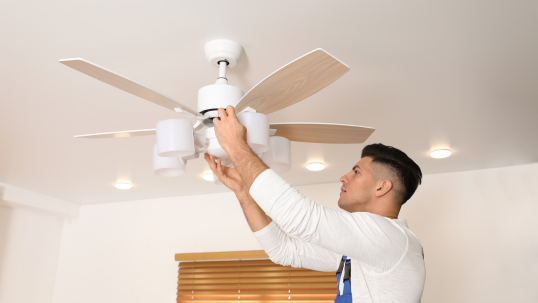Why Ceiling Fans Are Always In Style
Aesthetically minded and function-first crowds don’t care whether or not interior designers make a ceiling fan the focal point of a space. That’s because they know what these handy devices have to offer. Ceiling fans help lower heating and cooling costs and improve comfort in your Kissimmee home. On their own or as a complement to your home’s heating and cooling systems, ceiling fans are a surprisingly cost-effective solution to maximizing energy efficiency year-round.
How Do Ceiling Fans Work?
Ceiling fans create a gentle breeze and direct warm or cool air where it is needed most. To properly circulate air in a room, your fan needs to be the right size, with the right blade shape. And, the direction in which it spins also matters. Change the direction of your fan seasonally to maximize comfort and energy efficiency:
- Because warm air rises, a clockwise spinning fan will create an updraft, pushing warmer air down along the walls. Due to this, ceiling fans should spin clockwise in winter. After you set your ceiling fan direction for winter, select a low speed setting to avoid creating a breeze.
- The ceiling fan direction for summer is counterclockwise. This creates a downdraft that produces a cooling breeze throughout the room. The faster the fan spins, the more air it moves, and the more of a breeze you’ll feel.
Are Ceiling Fans Outdated?
No, ceiling fans aren’t outdated, and they remain a favorite option for Central Florida homeowners for several reasons. Despitebeing invented in 1882, ceiling fans are still one of the most effective cooling methods available to homeowners worldwide.
Ceiling Fan Efficiency
Are you wondering, “Are ceiling fans energy efficient?” Turn to ENERGY STAR for answers. MostENERGY STAR-rated ceiling fans are more energy efficient than central air conditioning units, although efficiency varies by model. They’re also more efficient than portable fans because they move substantially more air by volume.
Smart Ceiling Fans
Ceiling fan technology didn’t stop in 1882. Today’s ceiling fans have improved motor and blade designs to reduce energy use and move air more efficiently. Many fans can pair with smart home systems like Alexa or Nest, allowing your HVAC and ceiling fan to complement each other and further maximize your energy savings and comfort.
Read more: Energy Efficiency Tips To Save Money
How To Determine the Size of a Ceiling Fan
Before you take steps to wire up a new ceiling fan, first choose the right size fan. Ceiling fan sizes are based on the blade span, which is the full diameter of the circle the blades make when they spin. Measure your room, then find the right ceiling fan based on the square footage, according to ENERGY STAR:
- Rooms up to 100 square feet: 29- to 36-inch fan
- Rooms up to 400 square feet: 36- to 50-inch fan
- Rooms larger than 400 square feet: 50- to 71-inch fan
A fan that is too large can create an overwhelming breeze, while a fan that is too small will not provide enough airflow.
Are Ceiling Fans Worth It?
Yes! You can raise your thermostat by4 or 5 degrees during the summer with a well-maintained ceiling fan! This could contribute to measurable ceiling fan energy savings each year. In the winter, a ceiling fan helps to distribute heat more evenly, which can reduce how often and how long your heating system runs.
Our Ceiling Fan Expertise Makes Installation a Breeze
At Ace Solves It All, we know that energy efficiency has a real-world impact on your family budget. Our home services are designed to provide superior performance and worry-free use—from HVAC maintenance to ceiling fan installation, you can count on quality work by experienced, friendly technicians. We’re ready to help, so schedule your appointment today!
Call 407-499-8006 or contact us online to schedule HVAC, electrical, indoor air quality, or plumbing services in Kissimmee, Lakeland, and the surrounding areas.


